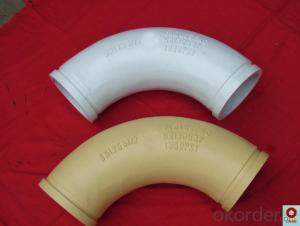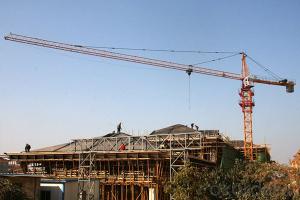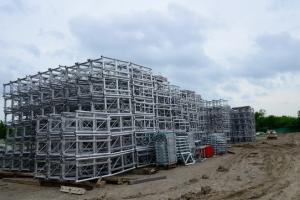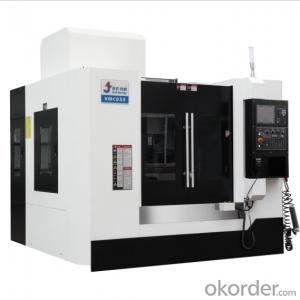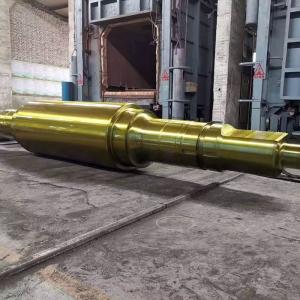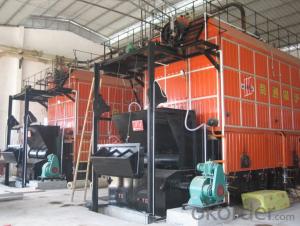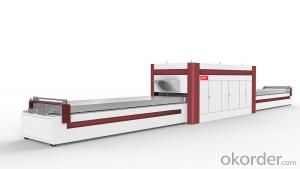CONCRETE DELIVERY ELBOW CIFATYPE 90DEG R275 DN125
- Loading Port:
- Tianjin
- Payment Terms:
- TT OR LC
- Min Order Qty:
- 100 pc
- Supply Capability:
- 10000 pc/month
OKorder Service Pledge
OKorder Financial Service
You Might Also Like
concrete pump elbow table
Wear-resistant Single or Double Concrete Pump Elbow | |||||||
Type | Singe Elbow | Double Elbow | |||||
Model | DN125 | DN150 | DN175 | DN125 | |||
Material | Casting Steel ,ST52 | Inside | 40Cr | Outside | |||
Size | R275*90° | R275*90°+110 | 36° | F2000 | R275*90° | R275*90°+110 | |
R275*45° | R275*90°+211 | R400*30° | A3000 | R275*45° | R275*90°+211 | ||
R275*25° | R275*90°+411 | R400*45° | 471B | R275*25° | R275*90°+411 | ||
R275*20° | R275*90°+424 | R400*30° | 571B | R275*20° | R275*90°+424 | ||
R275*15° | R275*45°+170 | R488*90° | A1000 | R275*15° | R275*45°+170 | ||
R180*90° | R275*45°+310 | R500*90 | C1000 | R180*90° | R275*45°+310 | ||
R232*60° | R275*45°+310 | R280*90° | B2000 | R232*60° | R275*45°+310 | ||
R240*36° | 20°Lengthen | R240*36° | 20°Lengthen | ||||
R240*30° | 25°+740 | R240*30° | 25°+740 | ||||
R240*15° | 40°Zoomlion | R240*15° | 40°Zoomlion | ||||
R385*29° | R385*29° | ||||||
R315*33° | R315*33° | ||||||
Technic | Forged | ||||||
Average life | 25,000cubic | 50,000cubic | |||||
Appliciation | Used in concrete transport in construction work | ||||||
1.product profile:The double layer concrete pump elbow is developed by ourselves through new
technology and process.
2.characteristic:the inner layer of this concrete pump elbow undergoes heat treatment,and then the rigitiry can reach 62-65HRC.
3.characteristic:the outer layer of the concrete pump elbow possess good toughness properties
to protect the inner layer,so the security of the elbow is improved.
4.life:the experiment done abroad shows that the life of our concrete pump elbow can reach 35000-50000cbm,got the customers' praise
5.Beside the double layer concrete pump elbow,we produce all kinds of concrete pump parts,
straight pipe hose flange coupling and so on.
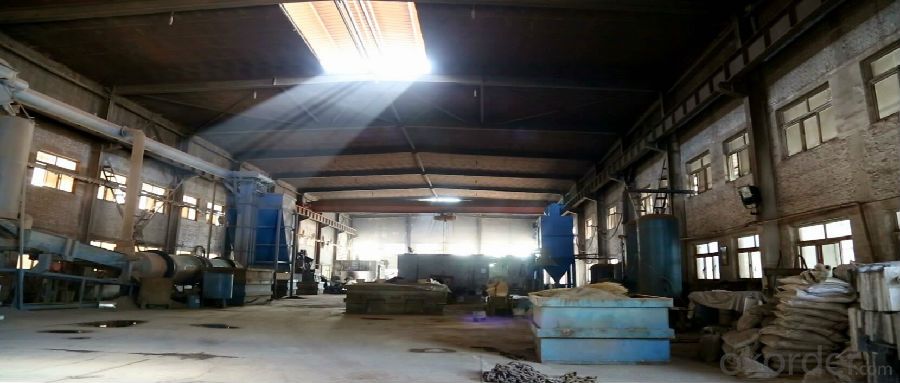
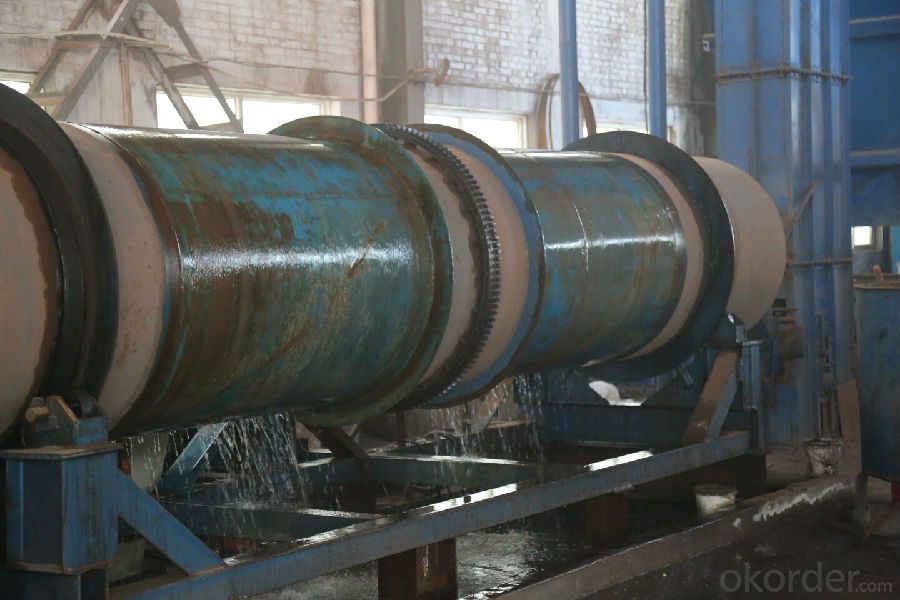

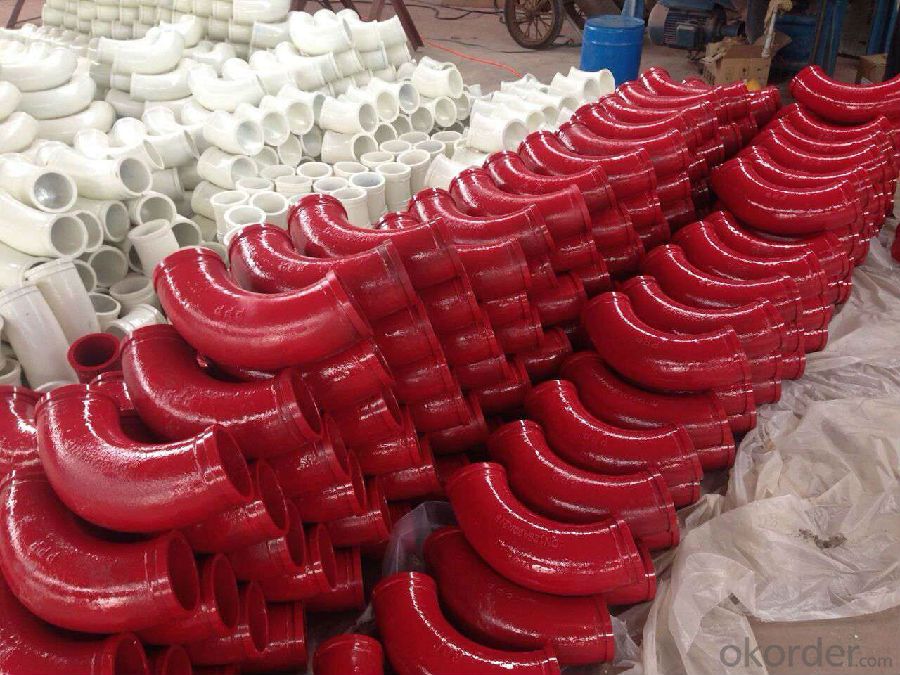
- Q:How often should hopper vibrators be inspected or replaced in a concrete pump?
- To ensure the proper functioning of hopper vibrators in a concrete pump and prevent any potential problems, it is important to conduct regular inspections. The frequency of these inspections or replacements may vary depending on several factors, such as the intensity of use, operating conditions, and the manufacturer's recommendations. As a general rule, it is recommended to inspect hopper vibrators at least once a year or after every 500-600 hours of operation, whichever comes first. However, if the concrete pump is heavily used or operates in harsh environments, more frequent inspections may be necessary. During the inspection, it is essential to check the hopper vibrators for any signs of wear, damage, or loose connections. Additionally, the vibration intensity and frequency should be assessed to ensure they are within the recommended range. Any issues identified during the inspection should be promptly addressed through repairs or replacements to ensure the hopper vibrators continue to function effectively. Regular inspections and timely replacements of hopper vibrators are crucial for maintaining the efficiency and reliability of a concrete pump. Neglecting these inspections can result in decreased performance, increased downtime, and potentially expensive repairs. Therefore, it is important to adhere to the manufacturer's guidelines and seek professional advice to determine the appropriate frequency for inspections and replacements based on the specific circumstances of your concrete pump.
- Q:How often should concrete pump control valves be inspected and replaced?
- Regular inspections should be conducted on concrete pump control valves to ensure their proper and safe functioning. The frequency of these inspections will vary depending on the specific conditions and usage of the pump. Generally, it is advised to inspect the control valves at least once every three to six months. However, if the pump is extensively used or operates in harsh conditions, more frequent inspections may be necessary. The decision to replace control valves should be made based on the inspection results and the recommendations of the manufacturer or a qualified professional. If the control valves display signs of wear, damage, or malfunction, immediate replacement is necessary to prevent any potential safety hazards or disruptions in the pump's operation. Timely replacement and regular maintenance of control valves are essential to ensure the concrete pump operates efficiently and safely.
- Q:How can one store and handle concrete pump spare parts to maintain their quality?
- To maintain the quality of concrete pump spare parts, it is crucial to store and handle them properly. Firstly, these spare parts should be stored in a clean and dry environment, away from moisture and direct sunlight. They should also be protected from dust and debris by using suitable covers or packaging. Additionally, it is important to handle them with care, avoiding any rough or improper handling that could cause damage. Regular inspection and maintenance of the spare parts should also be conducted to identify any signs of wear or corrosion, ensuring they are in optimal condition when needed for use.
- Q:How long do concrete pump pipes typically last?
- Concrete pump pipes typically last between 25,000 to 40,000 cubic meters of pumped concrete, depending on various factors such as pump usage, maintenance, and the type of concrete being pumped.
- Q:How often should concrete pump accumulators be inspected and replaced?
- To ensure proper functioning and prevent potential issues, it is important to regularly inspect concrete pump accumulators. The frequency of inspections will depend on factors such as manufacturer recommendations, usage intensity, and operating conditions. As a general rule, it is recommended to inspect the accumulators at least every six months or after every 500 hours of operation, whichever comes first. However, if the pump is used more frequently or operates under harsh conditions, more frequent inspections may be necessary. During the inspection, check the accumulators for visible signs of wear or damage, such as leaks, cracks, or corrosion. Additionally, test the pressure levels and performance to ensure they meet the required standards. When it is time for replacement, it is best to follow the manufacturer's recommendations. Typically, accumulators have a lifespan of around 3 to 5 years, but this can vary based on maintenance, usage, and environmental conditions. If any significant issues are found during the inspection or if the accumulators have reached their recommended lifespan, it is advisable to promptly replace them to avoid potential failures and ensure the safety and efficiency of the concrete pump.
- Q:Are there any specific safety precautions while replacing concrete pump spare parts?
- There exists a variety of safety precautions that must be followed when replacing concrete pump spare parts. 1. Personal Protective Equipment (PPE) is of utmost importance and should be worn to safeguard against potential hazards. This includes safety goggles, gloves, a helmet, and steel-toed boots. 2. It is essential to adhere to proper lockout/tagout procedures prior to replacing any spare parts. This entails disconnecting and securing the power source to prevent accidental startup of the pump. 3. Before commencing the replacement process, inspect all tools and equipment for any indications of damage or defects. It is crucial to refrain from using faulty equipment, as it can pose significant safety risks. 4. When handling heavy spare parts, it is imperative to employ appropriate lifting techniques to prevent strain or injury. Ensure that proper assistance and equipment, such as cranes or forklifts, are available if necessary. 5. Maintain a clean and well-organized work area to prevent trips, slips, and falls. Remove any obstacles or debris that may jeopardize safety during the replacement process. 6. Only trained and authorized personnel should be involved in the replacement of concrete pump spare parts. They must possess a thorough understanding of the equipment and procedures to minimize the likelihood of accidents. 7. Always consult the manufacturer's guidelines and instructions when replacing spare parts. This will ensure that the process is executed safely and accurately. 8. It is vital to have a plan in place for potential emergencies, including fires or injuries. Make certain that fire extinguishers and first aid kits are easily accessible, and that all workers are familiar with their locations and usage. By adhering to these safety precautions, the risk of accidents, injuries, and damage can be significantly reduced when replacing concrete pump spare parts.
- Q:Are there any specific maintenance requirements for concrete pump spare parts?
- Concrete pump spare parts have specific maintenance requirements that must be met to ensure optimal performance and prolong their lifespan. To achieve this, regular inspection and maintenance are necessary. Here are some key maintenance requirements for concrete pump spare parts: 1. Cleaning: It is important to regularly clean concrete pump spare parts such as pipes, hoses, and valves to remove any accumulated debris, hardened concrete, or contaminants. This can be accomplished by using appropriate cleaning agents and tools. 2. Lubrication: To minimize friction and wear, it is crucial to properly lubricate moving parts like pistons, cylinders, and bearings. It is recommended to use lubricants specifically designed for concrete pump spare parts, following the manufacturer's guidelines. 3. Inspection: Conduct regular inspections of all spare parts to identify signs of wear, damage, or misalignment. This includes checking for cracks, leaks, loose connections, or excessive wear in seals, O-rings, and gaskets. 4. Replacement: Promptly replace any damaged or worn-out spare parts to prevent further damage or potential breakdown of the concrete pump. It is essential to use genuine spare parts recommended by the manufacturer to ensure compatibility and performance. 5. Storage: When not in use, store concrete pump spare parts in a clean and dry environment to prevent corrosion or damage. Utilize proper storage racks or containers to keep the parts organized and protected. 6. Training: Adequately train operators and maintenance personnel on the correct handling, maintenance, and replacement procedures for concrete pump spare parts. This ensures that maintenance tasks are carried out correctly and efficiently. By adhering to these maintenance requirements, concrete pump spare parts can be maintained in excellent working condition, guaranteeing reliable and efficient operation of the concrete pump system. Regular maintenance not only helps prevent unexpected breakdowns but also enhances the overall performance and longevity of the spare parts.
- Q:Are there any specific maintenance procedures for concrete pump spare parts?
- Yes, there are specific maintenance procedures for concrete pump spare parts. Regular maintenance is crucial to ensure the effective functioning and longevity of the equipment. Here are some key maintenance procedures for concrete pump spare parts: 1. Lubrication: Regularly lubricate all moving parts such as pistons, cylinders, and valves to minimize friction and wear. This helps to maintain smooth operation and prevent premature failure. 2. Cleaning: Clean the spare parts regularly to remove any debris, dirt, or concrete buildup. Accumulated material can hinder the performance and cause damage to the parts. Use appropriate cleaning agents and tools to ensure a thorough cleaning. 3. Inspection: Conduct routine inspections of all spare parts to identify any signs of wear, damage, or deterioration. Check for cracks, leaks, loose connections, or any abnormal functioning. Timely detection of issues allows for prompt repairs or replacements. 4. Replacement: Replace worn-out or damaged concrete pump spare parts as soon as necessary. Delaying replacements can lead to further damage and potentially expensive repairs. Follow the manufacturer's recommendations for the lifespan of specific parts and replace them accordingly. 5. Calibration: Ensure that all spare parts are correctly calibrated to maintain optimum performance. This includes adjusting pressure settings, flow rates, and other parameters according to the manufacturer's guidelines. Regular calibration helps to ensure accurate and efficient concrete pumping. 6. Storage: Properly store spare parts when not in use to prevent damage from environmental factors. Keep them in a clean and dry place, away from direct sunlight or extreme temperatures. Additionally, follow any specific storage instructions provided by the manufacturer. 7. Training: Train operators and maintenance personnel on the proper handling, maintenance, and repair of concrete pump spare parts. This will ensure that the procedures are followed correctly, minimizing the risk of damage and maximizing the lifespan of the equipment. By following these specific maintenance procedures, concrete pump spare parts can be kept in optimal condition, enhancing their performance, reliability, and longevity.
- Q:How does a concrete pump piston work?
- By creating a back-and-forth movement, the concrete pump piston propels the concrete through the pump and into the desired location. The piston is a cylindrical part that fits snugly inside a cylinder and is connected to a rod, which is linked to a hydraulic system. When the hydraulic system is activated, it propels the rod forward, thereby causing the piston to move in the same direction. As the piston advances, it creates a vacuum behind it, which draws the concrete into the cylinder through an inlet valve. Once the piston reaches the end of its forward stroke, the hydraulic system changes its direction, retracting the rod and causing the piston to move backward. Consequently, this action closes the inlet valve and opens an outlet valve, enabling the concrete to be forced out of the cylinder and into the delivery line. The reciprocating motion of the piston, combined with the alternating opening and closing of the inlet and outlet valves, facilitates a continuous flow of concrete through the pump. This process is rapidly repeated, ensuring efficient and consistent pumping of concrete to the desired location.
- Q:How do I properly maintain and replace hydraulic pumps in concrete pump spare parts?
- Properly maintaining and replacing hydraulic pumps in concrete pump spare parts is crucial to ensure the smooth functioning and longevity of the equipment. Here are some steps to help you in this process: 1. Regular Inspections: Perform frequent visual inspections of the hydraulic pump to identify any signs of wear, leaks, or damage. Check for loose bolts, damaged seals, or excessive noise during operation. These inspections should be done before and after each use. 2. Follow Manufacturer's Guidelines: Refer to the manufacturer's guidelines and recommendations for maintenance and replacement of hydraulic pumps. They will provide specific instructions on the frequency of maintenance, lubrication, and replacement intervals. 3. Lubrication: Proper lubrication is essential for the smooth operation of hydraulic pumps. Check the oil levels regularly and top up if necessary. Use the recommended oil or hydraulic fluid as specified by the manufacturer. Follow the guidelines for the frequency of oil changes. 4. Regular Cleaning: Keep the hydraulic pump and its components clean from debris, dust, and dirt. Use a clean cloth or compressed air to remove any contaminants that may have accumulated. This will help prevent damage and reduce the risk of clogs or blockages. 5. Replace Worn Parts: Over time, certain components of the hydraulic pump may wear out and require replacement. Keep a stock of spare parts, including seals, gaskets, and filters, to be able to promptly replace any worn or damaged components. 6. Seek Professional Assistance: If you are unsure about any aspect of maintaining or replacing hydraulic pumps, it is always advisable to seek the assistance of a professional technician or the manufacturer. They have the expertise and knowledge to guide you through the process and ensure the best possible maintenance and replacement practices. Remember, regular maintenance and timely replacement of hydraulic pumps in concrete pump spare parts will not only extend the lifespan of the equipment but also ensure safe and efficient operation on construction sites.
1. Manufacturer Overview |
|
|---|---|
| Location | |
| Year Established | |
| Annual Output Value | |
| Main Markets | |
| Company Certifications | |
2. Manufacturer Certificates |
|
|---|---|
| a) Certification Name | |
| Range | |
| Reference | |
| Validity Period | |
3. Manufacturer Capability |
|
|---|---|
| a)Trade Capacity | |
| Nearest Port | |
| Export Percentage | |
| No.of Employees in Trade Department | |
| Language Spoken: | |
| b)Factory Information | |
| Factory Size: | |
| No. of Production Lines | |
| Contract Manufacturing | |
| Product Price Range | |
Send your message to us
CONCRETE DELIVERY ELBOW CIFATYPE 90DEG R275 DN125
- Loading Port:
- Tianjin
- Payment Terms:
- TT OR LC
- Min Order Qty:
- 100 pc
- Supply Capability:
- 10000 pc/month
OKorder Service Pledge
OKorder Financial Service
Similar products
New products
Hot products
Related keywords
